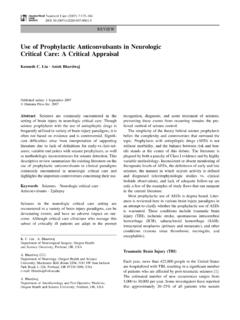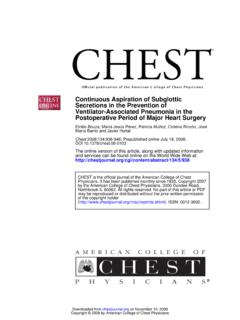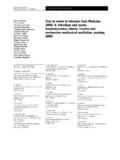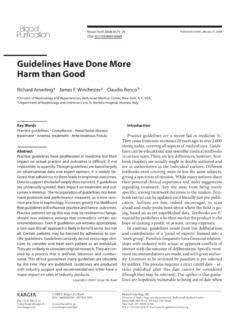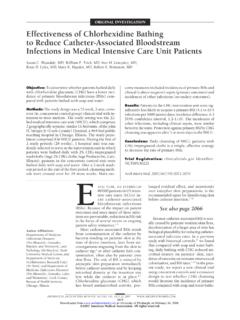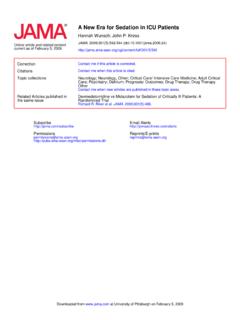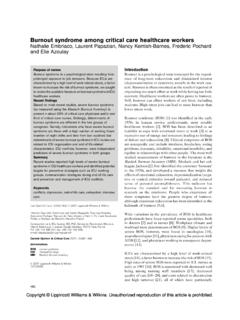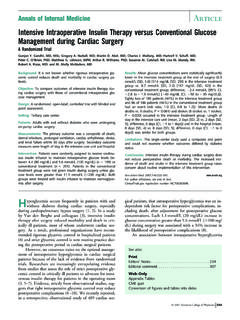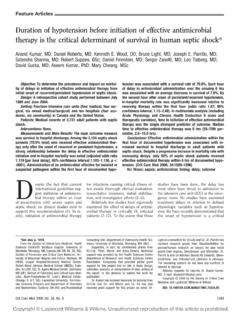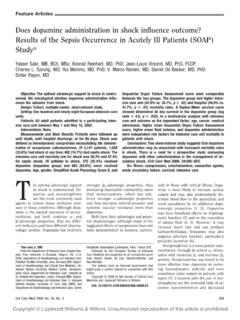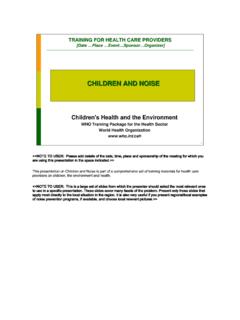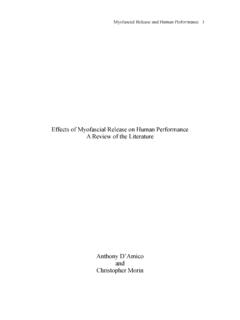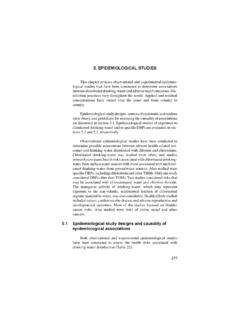Transcription of Cardiovascular response to dopamine and early …
1 Cardiovascular response to dopamine and early prediction of outcome in septic shock: a prospective multiple-center study *. Bruno Levy, MD, PhD; Benjamin Dusang, MD; Djillali Annane, MD, PhD; Sebastien Gibot, MD;. Pierre-Edouard Bollaert, MD, PhD; and the College Interregional Des R animateurs Du Nord-Est Objectives: To compare mortality rates between dopamine - interval, 3 25), arterial lactate > mmol/L (odds ratio, ;. sensitive (Dopa-S) and dopamine -resistant (Dopa-R) septic shock 95% confidence interval, ), and Sepsis-related Organ patients, the latter group defined by a mean arterial pressure <70 Failure Assessment score >10 (odds ratio, ; 95% confidence mm Hg despite the use of 20 g/kg/min dopamine .
2 Interval, ). Of the 110 patients studied, 66 were observed Design: A human, prospective observational, multiple-center, to be resistant to dopamine (60%). In the Dopa-S group, the clinical trial. 28-day mortality rate was 16% (seven of 44 patients) compared Setting: Ten intensive care units from ten hospitals. with 78% (52 of 66 patients) in the Dopa-R group (p .0006). The Patients: 110 patients with septic shocks. capacity of dopamine resistance to predict death was associated Interventions: Following volume resuscitation, patients were with a sensitivity of 84% and a specificity of 74%.
3 At 24 hrs, the treated by a rapid increase in dopamine infusion from 10 to 20 association of dopamine resistance to a lactate level > g/kg/min. If mean arterial pressure remained <70 mm Hg, mmol/L improved the prognostic value (sensitivity, 90%, speci- dopamine treatment was promptly switched to norepinephrine or ficity, 92%). epinephrine. Conclusions: dopamine sensitivity is associated with de- Measurements and Main Results: dopamine sensitivity, arte- rial gas, lactate, and organ system failure scores were measured creased mortality rate. early recognition of dopamine resistant at admission and after 6, 12, 24, 48, 72, 96, and 120 hrs.
4 The septic shock could allow for better screening of patients with an overall 28-day mortality rate was 54% for the entire population ominous prognosis. (Crit Care Med 2005; 33:2172 2177). under study . In multivariate analysis, independent predictors of KEY WORDS: septic shock; dopamine ; lactate; norepinephrine;. death were dopamine resistance (odds ratio, ; 95% confidence mortality. T he use of dopamine or nor- (3). Currently, it is unknown whether MATERIALS AND METHODS. epinephrine as first-line the use of a particular catecholamine agents in septic shock treat- regimen is able to influence patient Experimental Design and study ment has recently been rec- outcome (4, 5).)
5 Organization ommended by the Surviving Sepsis Clinical criteria generally used to Campaign guidelines for management definite septic shock do not allow for Ten medical or medical-surgical adult of severe sepsis and septic shock (1). early identification of patients with intensive care units (ICUs) from ten hospi- dopamine increases mean arterial pres- good or bad prognosis. Mortality in sep- tals (four university hospitals, one regional sure primarily by increasing cardiac in- tic shock is usually reported in hetero- hospital, and five general hospitals) partici- dex with minimal effects on systemic pated in the study .
6 This study was approved geneous populations (6). Our hypothe- vascular resistance (2). Thus, dopamine by our institutional review board. The study sis is that dopamine -sensitive patients was initiated in July 2001 and ended in April fails to increase mean arterial pressure when systemic vascular resistance is have a better prognosis than those with 2002. At the end of the study , an indepen- too low. dopamine -resistant septic a dopamine -resistant profile. This is dent diagnosis validation committee blindly shock was previously defined by the important since the ability to prospec- classified each patient as either unquestion- persistence of low arterial pressure de- tively identify patients with poor out- ably having had septic shock, probably hav- spite the use of 20 g/kg/min dopamine come is particularly helpful in properly ing had septic shock, or unlikely to have had designing clinical trials, in guiding septic shock.
7 All patients 18 yrs hospital- therapy, and notably in implementing ized in participating ICUs were prospectively enrolled in the study if they met all the *See also p. 2409. new therapeutic strategies (7). following criteria: a) a documented site (or From R animation M dicale, H pital Central, Nancy Hence, the present report is a prospec- at least strong suspicion) of infection, as Cedex, France (BL, SG, P-EB); and R animation M dicale. tive, multiple-center study that evaluates H pital Raymond Poincar , Garches, France (DA). evidenced by one or more of the following: The authors have no financial interests to disclose.
8 The predictive value of dopamine resis- presence of polymorphs in a normally sterile Copyright 2005 by the Society of Critical Care tance on mortality rate and characterizes body fluid (except blood), positive culture or Medicine and Lippincott Williams & Wilkins septic shock patients according to their Gram-negative stain of a normally sterile DOI: dopamine responsiveness. body fluid, clinical focus on infection ( , 2172 Crit Care Med 2005 Vol. 33, No. 10. Table 1. General characteristics of 110 patients with septic shock Patients were considered as responders when the increase was 15%.)
9 Volume resuscitation Survivors Nonsurvivors was considered optimal when, at a given level, n 51 n 59 p additional fluid infusion was no longer accom- panied by an increase in cardiac index. Age, yrs 59 14 63 14 .80 Norepinephrine or epinephrine ( 5 g/. Gender ratio, M/F .90 kg/min) with/without dobutamine (5 15 g/. Underlying diseases kg/min) was administered. If shock remained Cardiovascular 24 (47) 27 (46) .92. Liver 7 (14) 17 (29) .06. refractory, no further recommendations were Immunosuppression 6 (13) 9 (16) .85 elicited. McCabe classification Weaning of drugs was performed after a Nonfatal disease 24 (47) 23 (39).
10 60 12- to 24-hr period of hemodynamic stability, Ultimately fatal disease 24 (47) 28 (47) .86 using decreasing doses of catecholamine every Rapidly fatal disease 3 (6) 8 (13) .06 30 mins. There was no specific recommenda- Admission category tion for the use of low-dose hydrocortisone Medical 40 (78) 48 (81) .85 (200 300 mg/day). Elective surgery 3 (6) 4 (7) .85. Emergency surgery 4 (6) 7 (12) .60. Nosocomial-acquired sepsis 21 (41) 27 (46) .87 Data Collection at Inclusion Data are presented as mean SD or as number (%). Clinical Evaluation. On admission, the fol- lowing variables were recorded: a) general characteristics including age and gender, date Table 2.
